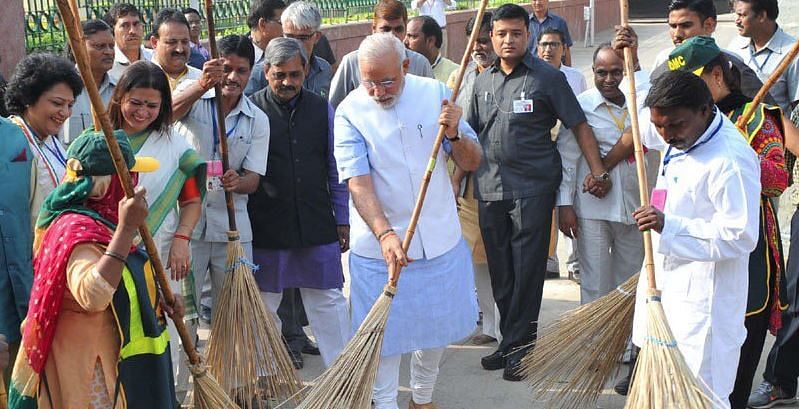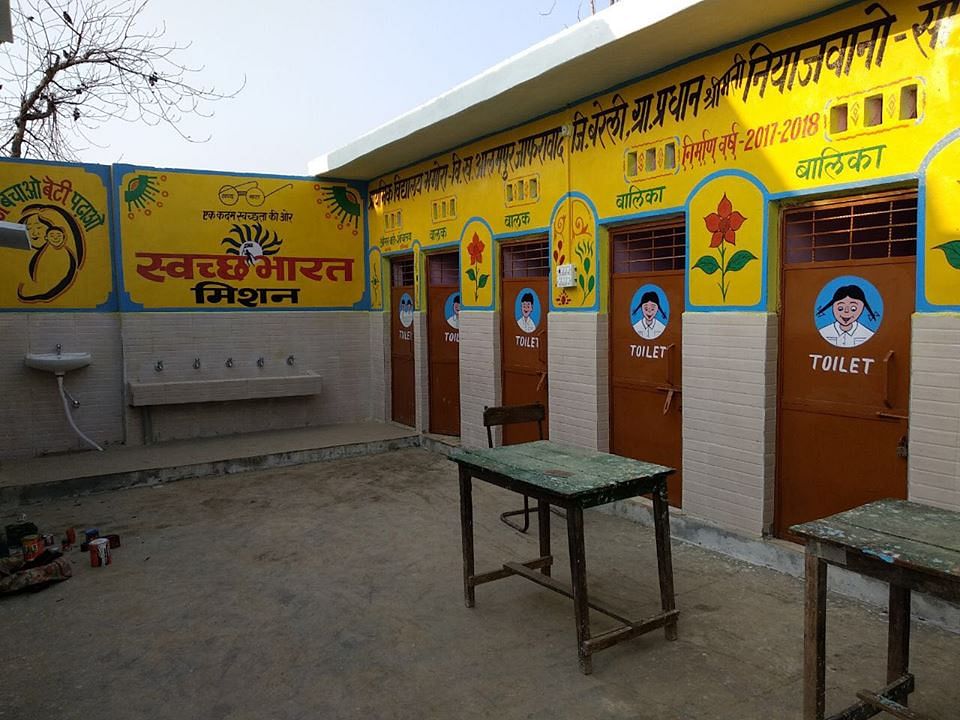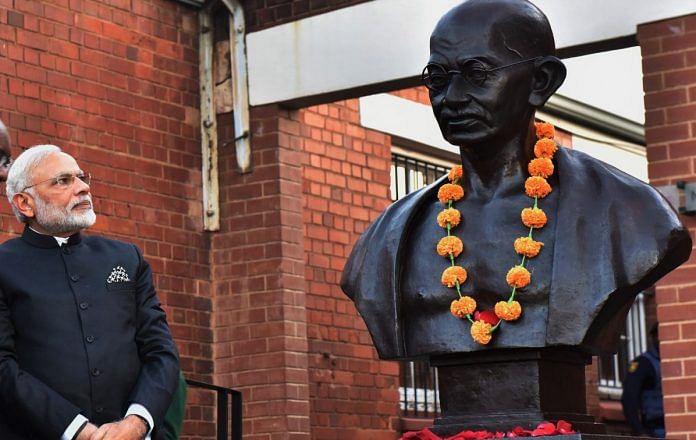If there has been one pet scheme of the Narendra Modi government, it is undoubtedly the world’s largest sanitation programme – the Swachh Bharat Mission. Right from the time Narendra Modi was the chief minister of Gujarat to his Independence Day speeches from the Red Fort as the prime minister, Modi has made sanitation a priority issue for both the government and the citizens for the first time.
Launched on 2 October 2014, as a tribute to Mahatma Gandhi, the Swachh Bharat Mission (SBM) seeks to make India completely open-defecation-free (ODF) by October 2019 – the 150th birth anniversary of Gandhi. Sanitation is a state subject and the central government can create awareness, provide incentives and frame guidelines that the states need to vigorously follow up on.
As per the central government’s guidelines, an ODF declaration is made when there is “no visible faeces found in the environment/village” and “every household, as well as public/community institutions, use safe technology” to dispose of faecal material. “Safe” here would mean non-contamination of surface soil as well as surface and groundwater, and non-exposure of excreta to flies leading to spread of diseases, infection and odour.

Also read: 93% rural households have access to toilets & 96.5% use them, says survey
Given the broad and largely vague definition and the scale of operation, this seemed like an impossible challenge in 2014 when Modi took over. According to UNICEF, when the SBM was launched in 2014, there were 111 million rural and about 10 million urban households in India that did not have a sanitary toilet. A staggering 564 million (accounting for 60 per cent globally) people defecated in the open.
Today, over nine crore toilets have been built across rural India under this mission. More than 5.5 lakh villages and 615 districts have been declared ODF, along with 30 ODF states and Union territories.
The National Annual Rural Sanitation Survey (NARSS) 2018-19 was conducted by an independent verification agency (IVA) between November 2018 and February 2019, covering 92,040 households in 6,136 villages across India’s states. The results were presented to an expert working group that had representatives of the World Bank, UNICEF, Bill and Melinda Gates Foundation and so on. The survey found that the SBM-Grameen had succeeded in ensuring 96.5 per cent of households in rural India have access to a toilet. It also confirmed the ODF status of 90.7 per cent of the villages that had already been declared so. From a sanitation coverage of 38.7 per cent in 2014, the surge to 99.06 per cent in 2019indicates a phenomenal increase.
Way back in 2017, an interim assessment of the Swachh Bharat Mission by the UNICEF indicated that on an average, households in ODF villages accrued cumulative benefits of Rs 50,000 per year. These benefits came from savings on medical costs that would have been incurred due to sickness caused by the filth and open defecation. It also factored in the value of lives saved and the reduction of time lost due to sickness and finding a suitable place to defecate.
Especially in children, the scourge of open defecation led to contamination of food and drinking water, causing the spread of diarrhoea, malnutrition and childhood stunting — something that cost India 6.4 per cent of its GDP, as per a World Bank estimate.
Households with toilets saw its property value increase too at an average of Rs 19,000.

Also read: Menstrual hygiene must be made part of Swachh Bharat & Beti Bachao, Beti Padhao
The World Health Organization (WHO) claims that once completed in October 2019, the SBM-Grameen would help avert more than 3,00,000 deaths, caused mainly by diarrhoea and protein-energy malnutrition. Before 2014, the WHO reported 199 million annual cases of diarrhoea and other illnesses in rural India. This figure has been steadily falling, with more than 14 million cases being avoided.
No wonder UNICEF’s Executive Director Henrietta Fore heaped praise on Prime Minister Modi in October 2018 for investing his “political time and efforts” on issues that often get sidelined, like health and sanitation. “If you invest a dollar in sanitation solutions, the benefit will be four dollars in terms of health cost prevention, the (reduction in) number of visits you go to a doctor and in the medicines that you don’t have to buy,” she said.
Given the sensitive nature of the subject, it was difficult to gather too many details from “beneficiaries”. However, a few voices spoke up about how the scheme had changed their lives for the better.
Sampath Kumar from Vatavagar village in Coimbatore mentions that there has been a tremendous spurt in the construction of toilets since the launch of SBM. “Several others in my village and I got an allowance of Rs 12,000 to construct quality toilets in our houses. Several awareness campaigns too were launched. Now, five villages in our block have been declared ODF,” he said.
Mansa Ben from Gujarat’s Patan would dread the idea of walking long distances for her daily ablutions. Fearing the safety of her young daughter, she would accompany her as well. People kept wandering around in the fields and to “quickly finish our chore before getting noticed” was a huge dent to their dignity. A pucca toilet in their home now at a cost of Rs 10,000 has made their lives much more comfortable and dignified.
Arti Gautam who works in a school in Sikkim notes with concern how the absence of toilets in their schools led many students to defecate in the open, causing frequent sickness. “Importantly many girl students started dropping out of school. Now, under Swachh Bharat, a toilet has been constructed in our school. And suddenly, the girls who had dropped out are coming back. It has also led to greater attendance levels among all students and fewer cases of diarrhoea,” she adds.
Earlier this year, Prime Minister Modi gave away the Swachh Shakti awards to a dozen women sarpanches, who had motivated their villages to achieve 100 per cent sanitation. Regular Swachh rankings have created healthy competition among states, cities and districts. But, while the government can allocate funds and Prime Minister Modi can lead the optics of the campaign by wielding a broom or nominating eminent people to spread the message, the success of the SBM can only come from public-participation and complete behavioural transformation. Despite a toilet being there, driven by old habit, many people continue to use the fields.
In some cases, people availed the Rs 12,000 given to them under the SBM to build a toilet to marry off their daughters. A sample study in Madhya Pradesh showed that low toilet usage was also linked to caste disadvantages. The Balai caste, for instance, were found to be more disadvantaged both in terms of using toilets and accessibility to communication efforts undertaken to induce behavioural change.

Also read: Swachh Bharat has made little difference, govt should factor in criticism
But the ingenious ways that people seem to have devised to circumvent this problem have been heartening. Even young, inspired children like Yashraj from Madhya Pradesh’s Baigram village formed a “Vaanar Sena” with his friends to stop the open-defecation habit. “We got up at 5 am and set out to different parts of our village. Whenever we saw people easing themselves in the open, we would start blowing horns or whistles and throw away their water mugs. This would shame many people who would run away, abusing us. Slowly, they have started using the constructed toilets,” beamed Yashraj.
Noting this behavioural change, Val Curtis, director of the London School of Hygiene and Tropical Medicine’s Environmental Health Group who has worked on the SBM mentioned, “It’s the biggest, most successful behaviour-change campaign in the world…Every time I go there, I feel like I can’t sit down for weeks after because I’m excited about what they’re doing. It’s incredible.”
The dream of the Father of the Nation was total sanitation for all. “Sanitation is more important than independence,” Gandhi had said. There could be no better tribute to him than the realisation of his dream by the time we commemorate his 150th birth anniversary.
This is the ninth part of a series on the author’s conversations with beneficiaries of schemes launched by the Narendra Modi government. Read the others here.
The author is a writer/historian/political analyst and a Senior Fellow at the Nehru Memorial Museum and Library, with an upcoming biography of Savarkar



